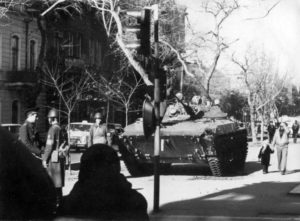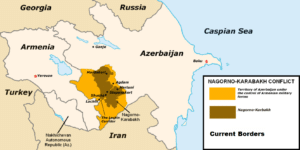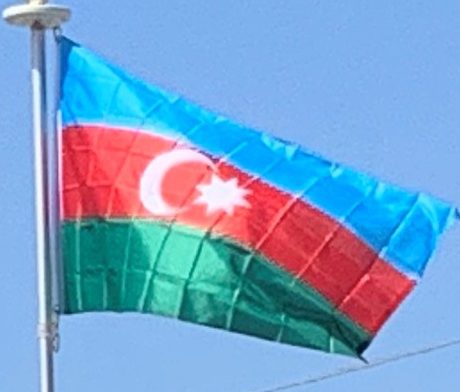During World War II, Azerbaijan played a crucial role in the strategic energy policy of the Soviet Union, with 80 percent of the Soviet Union’s oil on the Eastern Front being supplied by Baku. By the Decree of the Supreme Soviet of the USSR in February 1942, the commitment of more than 500 workers and employees of the oil industry of Azerbaijan were awarded orders and medals. Operation Edelweiss carried out by the German Wehrmacht targeted Baku because of its importance as the energy (petroleum) dynamo of the USSR. A fifth of all Azerbaijanis fought in the Second World War from 1941 to 1945. Approximately 681,000 people with over 100,000 of them women went to the front, while the total population of Azerbaijan was 3.4 million at the time. Some 250,000 people from Azerbaijan were killed on the front. More than 130 Azerbaijanis were named Heroes of the Soviet Union. Azerbaijani Major-General Azi Aslanov was twice awarded the Hero of the Soviet Union.
Independence:
Following the politics of glasnost, initiated by Mikhail Gorbachev, civil unrest and ethnic strife grew in various regions of the Soviet Union, including Nagorno-Karabakh, an autonomous region of the Azerbaijan SSR. The disturbances in Azerbaijan, in response to Moscow’s indifference to an already heated conflict, resulted in calls for independence and secession, which culminated in the Black January events in Baku.

Later in 1990, the Supreme Council of the Azerbaijan SSR dropped the words “Soviet Socialist” from the title, adopted the “Declaration of Sovereignty of the Azerbaijan Republic” and restored the flag of the Azerbaijan Democratic Republic as the state flag. As a consequence of the failed coup which occurred in August in Moscow, on 18 October 1991, the Supreme Council of Azerbaijan adopted a Declaration of Independence which was affirmed by a nationwide referendum in December 1991, while the Soviet Union officially ceased to exist on 26 December 1991. The country now celebrates its Independence Day on 18 October.

The early years of independence were overshadowed by the Nagorno-Karabakh war with the ethnic Armenian majority of Nagorno-Karabakh backed by Armenia. By the end of the hostilities in 1994, Armenians controlled up to 20 percent of Azerbaijani territory, including Nagorno-Karabakh itself. During the war many atrocities were committed including the massacres at Malibeyli and Gushchular, the Garadaghly massacre, the Agdaban and the Khojaly massacres. Furthermore, an estimated 30,000 people have been killed and more than a million people have been displaced. Four United Nations Security Council Resolutions (822, 853, 874, and 884) demand for “the immediate withdrawal of all Armenian forces from all occupied territories of Azerbaijan.” Many Russians and Armenians left Azerbaijan during the 1990s. According to the 1970 census, there were 510,000 ethnic Russians and 484,000 Armenians in Azerbaijan.
In 1993, democratically elected president Abulfaz Elchibey was overthrown by a military insurrection led by Colonel Surat Huseynov, which resulted in the rise to power of the former leader of Soviet Azerbaijan, Heydar Aliyev. In 1994, Surat Huseynov, by that time the prime minister, attempted another military coup against Heydar Aliyev, but he was arrested and charged with treason. A year later, in 1995, another coup was attempted against Aliyev, this time by the commander of the OMON special unit, Rovshan Javadov. The coup was averted, resulting in the killing of the latter and disbanding of Azerbaijan’s OMON units. At the same time, the country was tainted by rampant corruption in the governing bureaucracy. In October 1998, Aliyev was reelected for a second term. Despite the much improved economy, particularly with the exploitation of the Azeri-Chirag-Guneshli oil field and Shah Deniz gas field, Aliyev’s presidency was criticized due to suspected election frauds and corruption.
